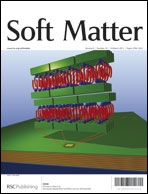In this paper, a novel thixotropic injectable hydrogel has been developed by blending regenerated silk fibroin (SF) and hydroxypropylcellulose (HPC). Dynamic oscillatory rheology showed that the blends gelled at 37 °C within 1 h, and the gelation kinetics and gel properties were controllable by tuning the mix ratio of the blends. The gelation mechanism of such blends was elucidated from morphological observations by confocal laser scanning microscopy (CLSM), structural characterization and a molecular mobility study viaRaman spectroscopy and quantitative 13C-NMR spectroscopy, respectively. The results suggested that the phase separation of the blends triggered the conformational transition of SF from random coil to β-sheet, and thus resulted in the gel network formation through the β-sheet crosslinks and the immobilization of the molecular chain in the dispersed phase. Moreover, it was demonstrated that the blend hydrogel could protect encapsulated cells against high shear force during injection, suggesting that the SF–HPC hydrogel is a promising vehicle for cell delivery. This injectable hydrogel with thixotropic rheological properties was expected to potentially overcome the problem of leakage of liquid precursors to neighboring tissues associated with the in situ formation of injectable hydrogels.

You have access to this article
 Please wait while we load your content...
Something went wrong. Try again?
Please wait while we load your content...
Something went wrong. Try again?


 Please wait while we load your content...
Please wait while we load your content...